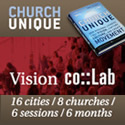Study: Growing Churches Have More Men and Drums
- Posted by: Todd
- Posted on: Wed, January 03, 2007
- Viewed 42
- (15) comments so far
That’s the conclusion of a December report from the Hartford Institute for Religion Research, a nonprofit research group at Hartford Seminary in Hartford, Conn. While most US churches continue to be predominantly of one race and to count more women than men in their pews, the HIRR survey of almost 900 congregations found growth is most likely when:
• A church is multiracial.
• Men make up at least 60 percent of regular participants.
• Leaders describe worship as “slightly to not at all” reverent.
• Drums or percussion are always used in worship.
Such innovations make churches exciting places to be, says report author Kirk Hadaway. It also explains why atypical churches, which are prone to innovate, often lead the pack in growth, he adds.
“If it’s not uplifting, interesting, provoking ... it’s perfectly acceptable in American society to not go [to church] anymore,” says Mr. Hadaway, director of research for the Episcopal Church USA. “Churches that are providing a more uplifting worship experience and community are those that are growing. And those that do it well are not typical anymore.”
For many congregations, learning to grow is a matter of survival. Six mainline denominations, all of which have been losing members for 40 years, saw worship attendance figures drop by as much as 12 percent between 1999 and 2004, according to a November report from the Presbyterian Church (USA). The United Methodist Church (UMC) lost about 34,000 weekly worshipers, or 1 percent, from 2004 to 2005.
“We have a sense of mission to reach new people with the Gospel and to minister to people’s needs - that’s why we exist - and we realize that we’re failing in our mission,” says John Southwick, director of research for the General Board of Global Ministries for the UMC. “We need to turn the ship around, and that means to start growing again.”
For stagnant or declining congregations, Hadaway says, the new findings, based on data collected in 2005, offer hope because churches can usually cultivate at least a few attributes correlated with growth. But, church experts caution, this prescription for growth won’t work if a congregation doesn’t also lay the necessary groundwork.
“You cannot simply introduce tactics in worship design and hope to increase the number of males or become more cross-cultural,” says Thomas Bandy, president of Easum, Bandy & Associates, a Texas-based church-growth consultancy. “It requires a certain kind of leader” to build consensus and trustworthy spiritual authority, or else other changes in congregational life become mere superficialities.
What’s more, according to Bandy and Hadaway, changing a congregation’s attributes often creates stress and conflict, which HIRR found to be the No. 1 factor when attendance takes a dive.
But perhaps the bigger danger in racing to emulate growing churches is losing sight of more primary priorities, according to theologian Philip Kenneson.
“I don’t think there are any bonuses just for getting people in the door,” says Mr. Kenneson, an associate professor at Milligan College in Tennessee and co-author of “Selling Out the Church: The Dangers of Church Marketing.” “I want my children to be formed by a community of believers [that shape] a certain kind of people. It’s not enough to just be there being counted.”
Still, atypical congregations of many stripes are counting their blessings as new worshipers beef up the flock’s ranks. On the liberal side, gay-friendly Metropolitan Community Church of Toronto recently hosted the largest Christmas Eve service in Canada with nearly 2,500 attendees. With more than 30 ethnic groups represented in the pews, the congregation expects to keep building its average weekly attendance from 580 today to about 875 within the next three years.
More-conservative congregations are also benefiting from ethnic diversity and joyful environs. Granger Community Church, a drum-loving congregation near South Bend, Ind., has seen weekly attendance grow from about 2,000 in 2000 to 5,700 in 2006. First Baptist Church of Wheaton, Md., has boosted average weekly attendance over the past four years from 190 to about 225, an 18 percent gain. Bringing minority faces up front to lead songs and prayer has helped make the church 50 percent nonwhite, according to Larry White, minister of spiritual formation. Another plus: Professional musicians, including a drummer, have helped increase the ranks of young adults.
“The universal language of rock ‘n’ roll sets the stage for people of many different backgrounds to be comfortable in our setting,” Mr. White says. Although electric guitars have turned off some older members, White says, most have been willing to tolerate it as an important drawing card for younger newcomers.
In some cases, old-fashioned pastoral care still wins attendees. When newcomers visit Assembly of God Brazilian Church, a growing Pentecostal congregation in Abington, Mass., lay evangelist Fausto de Rocha follows up with a home visit. There, he prays with them. If they don’t speak English, he makes calls to set up phone and cable television service. The church also offers language classes and helps newcomers find jobs.
“These are immigrants far away from their home and the love they knew there,” Mr. de Rocha says. But they tend to relax, he says, around top- notch singers, horns, and drums at Sunday services.
SOURCE: The Christian Science Monitor article by G. Jeffrey MacDonald
TAGS: Church Growth; Megachurch
For Discussion: So… what are your observations? Do growing churches all have more men; use drums and are multicultural? What else stuck out to you in this article?
Churches with rising attendance numbers have a lot in common with one another - a lot more than denomination, location, or even theological approach. According to a new study, success stories often involve men, drums, a joyful environment, and a concerted effort not to be too "reverent."
Comments
if you want a Globally Recognized Avatar (the images next to your profile) get them here. Once you sign up, they will displayed on any website that supports them.






Peter Hamm on Wed, January 03, 2007
They say these growing churches are mostly men, which means they have leaders that attract men or they target men in many cases I’m sure… But no mention of age demographics. I wonder if those who target the very young show any kind of blip in the data.
Wendi on Wed, January 03, 2007
I can’t recall the last time I attended a church that didn’t have drums, and I visit a lot.
I do think that it’s important to consider things that might be comfortable to “churched” men, but completely awkward to an unchurched man - - - like grabbing the hand of the man sitting next to you to pray. Though I don’t like the pejorative tone of Mark Driscoll’s term “chickified,” I think it might apply to the men holding hands concept. I think that when we step back and evaluate all the things we do and say, one might think our target audience is women and very churched men. That said, I don’t think that having women equally in leadership or occasionally in the preaching rotation is the kind of thing which would keep an unchurched male away.
Whatever a declining church needs to consider in order to turn the tide and realize genuine and sustained conversion growth, Bandy’s comment in the article is important to consider.
[What’s more, according to Bandy and Hadaway, changing a congregation’s attributes often creates stress and conflict, which HIRR found to be the No. 1 factor when attendance takes a dive.]
I’m reminded of Collins’ Good to Great companies. Often these took significant risks, made deep changes that resulted in short term losses and long term significant and sustainable growth.
Wendi
RevJeff on Wed, January 03, 2007
Like… DUH!…
How many churches (I mean no offense to Godly women) are full of women who are prayig and begging for the church (pastor) to reach out to their husbands? In nineteen years of Youth/Pastoring, I only remember one sold out man who’s wife didn’t want anything to do with the church that was transforming her husband’s life…
Men who know Christ, and follow Him by serving at work and in their homes are powerful are very attractive to the women they live with!
Daniel on Wed, January 03, 2007
I’m actually surprised by the multiracial factor. I was under the impression that the best way (to speak in worldly terms) to build a congregation was to appeal to a single demographic (e.g. middle class whites). Of course, our Kingdom calling compels us to break down the racial and ethnic walls which divide us, but this is often quite difficult. I’m overjoyed to hear that congregations which do this are actually growing!
And Wendi, you’re right that Driscoll’s tendency to villify femininity is annoying, but I do think he’s correct that many (evangelical) churches pull primarily on women’s heart strings. This isn’t bad, but it needs to be balanced (which is why it’s ideal for there to be both men and women in leadership—and in the congregation). As image bearer’s of the God who created both masculinity and femininity (and who transcendently embodies both), we can’t afford to either ‘chickify’ or ‘dudify’ our churches (or rephrased, we need both chickification and dudification).
As a final note, one would be wise to remember that building the Kingdom isn’t synonymous with having more numbers. You could have a church packed full of baby Christians who are still (to borrow from St. Paul), ‘drinking milk’. A church should focus on intensive discipleship at least as much as it does on growth (this is not an either/or kind of thing, of course).
My two cents.
Cheers!
-Daniel-
Dave on Thu, January 04, 2007
“Bringing minority faces up front to lead songs and prayer has helped…”
The church my parents attend in Pittsburgh, PA (http://www.acac.net) has taken this exact path in trying to reach a multi-ethnic community. It has been very successful. Well, they actually hired the minority faces as pastoral staff. They are bursting at the seams with a very diverse congregation of committed believers and are having a huge impact on the urban community in which the church has stood for 50+ years. Awesome place to worship. Oh yeah… lotsa guya and drums too.
Dave
nora on Thu, January 04, 2007
Ah, yes, “to be absent from the organ is to be present with the men.” http://www.mondaymorninginsight.com/images/smileys/smile.gif Seriously, though, I think the presence of of drums is really too broad of an indicator to be really helpful. What it does say, IMO, is that those churches who don’t have drums by this rather late date, are not interested enough in reaching the lost to even put forth a minimum of effort to do so.
Paul Terrazas on Mon, January 08, 2007
While reading the column I could not help reading between the lines. My first thought was that many of these churches mentioned seem to have congregations that are there for Sunday service and nothing more. As I understand it, Jesus called us to action (individually) and that we are to go out and serve, not be served. During our worship, we are not the audience! We are there for God! It is so hard for me to understand why we have such a consumer mentality; even in our service to God.
All too often we (the church body) have the idea that it is up to the pastor or the church to reach the lost. To put it in perspective, the pastor is the shepherd of the flock; we are the sheep. If my high school biology serves me correctly after these many years, isn’t it up to the sheep to make more sheep? I can’t recall reading where a shepherd is responsible for creating more sheep. We should not depend on the pastor to reach the lost; that is our job. Our pastors’ job is to preach the Word!
While the study provided some interesting points, such as drums in the church equals more men. This is hardly what causes a church to grow properly. Who wants a church that is bursting at the seams with attendees that have no spiritual depth? As far as having more men in the church – when men begin to show a spirit of servant hood, and draw close to God, I guarantee more men will begin attending. Also keep in mind, if what is preached cannot be applied to one’s life, there is little growth if any. Show men how relevant the Word of God is to their lives and they will hunger for it.
Okay, time to jump off of the soapbox!
David S. on Mon, January 08, 2007
Nora,
I can’t help but wonder how having drums in a church is proportional to the churches concern for the lost. Does that mean that having an organ playing the hymns means a church is unconcerned about the lost?
How does having a drum set on the platform equal a minimum effort to reach the lost? The last time I checked, the gospel was communicated by Godly people burnened by the Holy Spirit for their fellow man, rather than by a drum set!
—Dave
nora on Tue, January 09, 2007
Dave S. asked, “How does having a drum set on the platform equal a minimum effort to reach the lost? The last time I checked, the gospel was communicated by Godly people burnened by the Holy Spirit for their fellow man, rather than by a drum set!” Obviously, the communication of the Gospel starts with God’s people fulfilling their God-given commission. However, (and it’s been argued on this site many times) if God’s people are attempting to communicate the Gospel to Hispanics, and insisting on speaking English, no matter how fervent, passionate, and holy the messengers may be, the message itself is going to have a very low delivery rate. I am not arguing that drums are more holy than organs; in fact, in another 20 years, drums may be passe. Right now, however, in this American culture, I can tell you that I know NOBODY in my age group, and certainly no one younger, who listens to organ music recreationally. But I can tell you that 95% of all the popular, contemporary music out there (and I’m including Christian music) utilizes the drums. So, IF a particular church wishes to use a weekend service for worship, discipleship, and reaching out to the lost (and maybe they don’t), the MINIMUM effort would require the use of the drums. A church may have a heart to reach the lost and still want to use the organ and not the drums, but if they are successful, their success will come in spite of, and not because of that organ, IMO.
So to answer your question more directly, I do think that churches can play hymns on the organ and still be concerned about the lost; what I doubt is their efficacy in reaching them.
Just my completely biased opinion. http://www.mondaymorninginsight.com/images/smileys/smile.gif
David S. on Tue, January 09, 2007
Nora,
I agree with what you said about being culturally relevant. I don’t listen to organ music either! However, I still don’t see how the level of contemporary music in a church (drums) is proportionate to their concern for the lost. Not every church is blessed enough to have the people and talent to have a contemporary praise band leading worship every Sunday. Some churches, mine included, have one musical person - and when she is gone, we have to sing acapella! However, our church has a concern for the lost.
You said, “A church may have a heart to reach the lost and still want to use the organ and not the drums, but if they are successful, their success will come in spite of, and not because of that organ, IMO. “ I completely agree, and IMO, you can swap “drums” for “organ.” If a church is concerned about reacing the lost and are successful, the success will come in spite of, and not because of that drum set. The only thing that is required as a “MINIMUM effort” for reaching the lost is a knowledge of how to share the gospel message and a burden for those who need to hear it.
Now, even though I said what I said above, at the same time, I’d love to have more contemporary music in our services - I don’t have anything against it. I’m not desiring it because I want it as an outreach tool, but for exactly what you stated before, no one listens to organ music recreationally. When the traditional hymns that many churches still sing were written, the pipe organ was the instrument of the day. I’d like to sing many of those same great hymns of the faith to a contemporary music style. I think our people would get more out of worship with a more contemporary style of music to sing to. So, while I would like to have more contemporary music in our services, I don’t think it’s a requirement in order to reach the lost, or to show our level of concern for the lost.
Peter Hamm on Wed, January 10, 2007
David S writes
[However, I still don’t see how the level of contemporary music in a church (drums) is proportionate to their concern for the lost.]
It isn’t porportionate to their concern for the lost.
It just HAPPENS, I am guessing, that a church that happens to have contemporary music happens to be growing because they have chosen music that reaches into the culture of their “target audience”. They have been intentional about the way they present worship rather than doing things “the way they’ve always done it.”
And… all you need to get something like that started is one good musician with a guitar who can sing. Eventually, the bass players and drummers will show up…
Wendi on Wed, January 10, 2007
In commenting about the use of drums as related to reaching the lost, Peter writes:
[It just HAPPENS. I am guessing, that a church that happens to have contemporary music happens to be growing because they have chosen music that reaches into the culture of their “target audience”. They have been intentional about the way they present worship rather than doing things “the way they’ve always done it.”]
EXACTLY!! The church that doesn’t use drums provides an allegory for a church that has neither intentionality nor a willingness to exegete their culture, which will always result in a lack of effectiveness in reaching the lost.
Wendi
Peter Hamm on Wed, January 10, 2007
Even better!
Wendi always says stuff so much better than I do! Jesus loves everybody, but Wendi is surely his favorite!
http://www.mondaymorninginsight.com/images/smileys/wink.gif
nora on Wed, January 10, 2007
Thanks, Peter and Wendi, for making the point so much more clearly than I did. And for the record, I think you’re both Teacher’s Pets! http://www.mondaymorninginsight.com/images/smileys/wink.gif
Flora on Tue, July 07, 2009
Good afternoon. I like an escalator because an escalator can never break, it can only become stairs. There would never be an escalator temporaly out of order sign, only an escalator temporarily stairs. Sorry for the convenience. Help me! Help to find sites on the: Accredited online mba schools. I found only this - auto loan. Displaying results for online mba degree. Home page online mba degree articles. Waiting for a reply :cool:, Flora from Ukraine.
Page 1 of 1 pages
Post a Comment